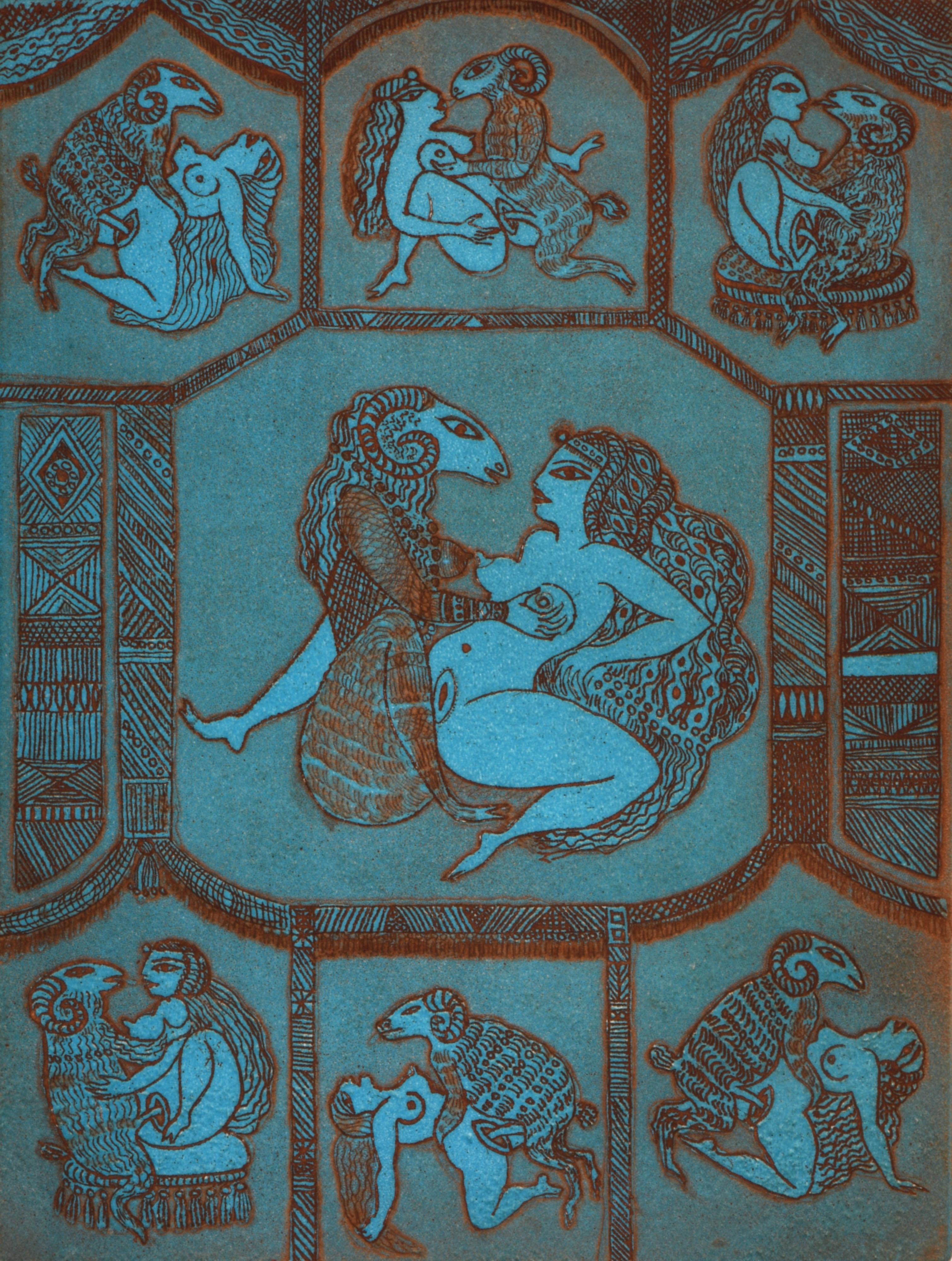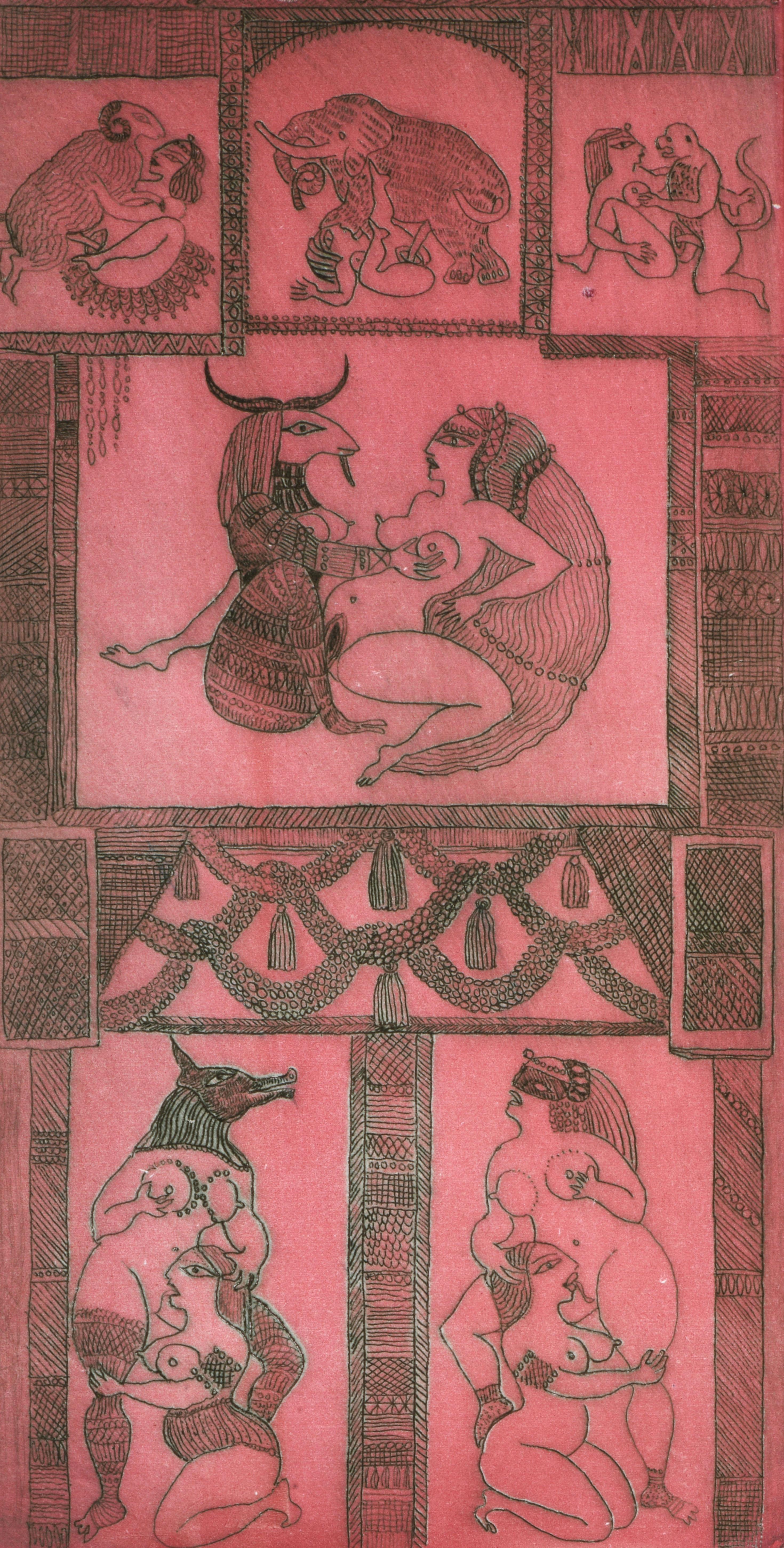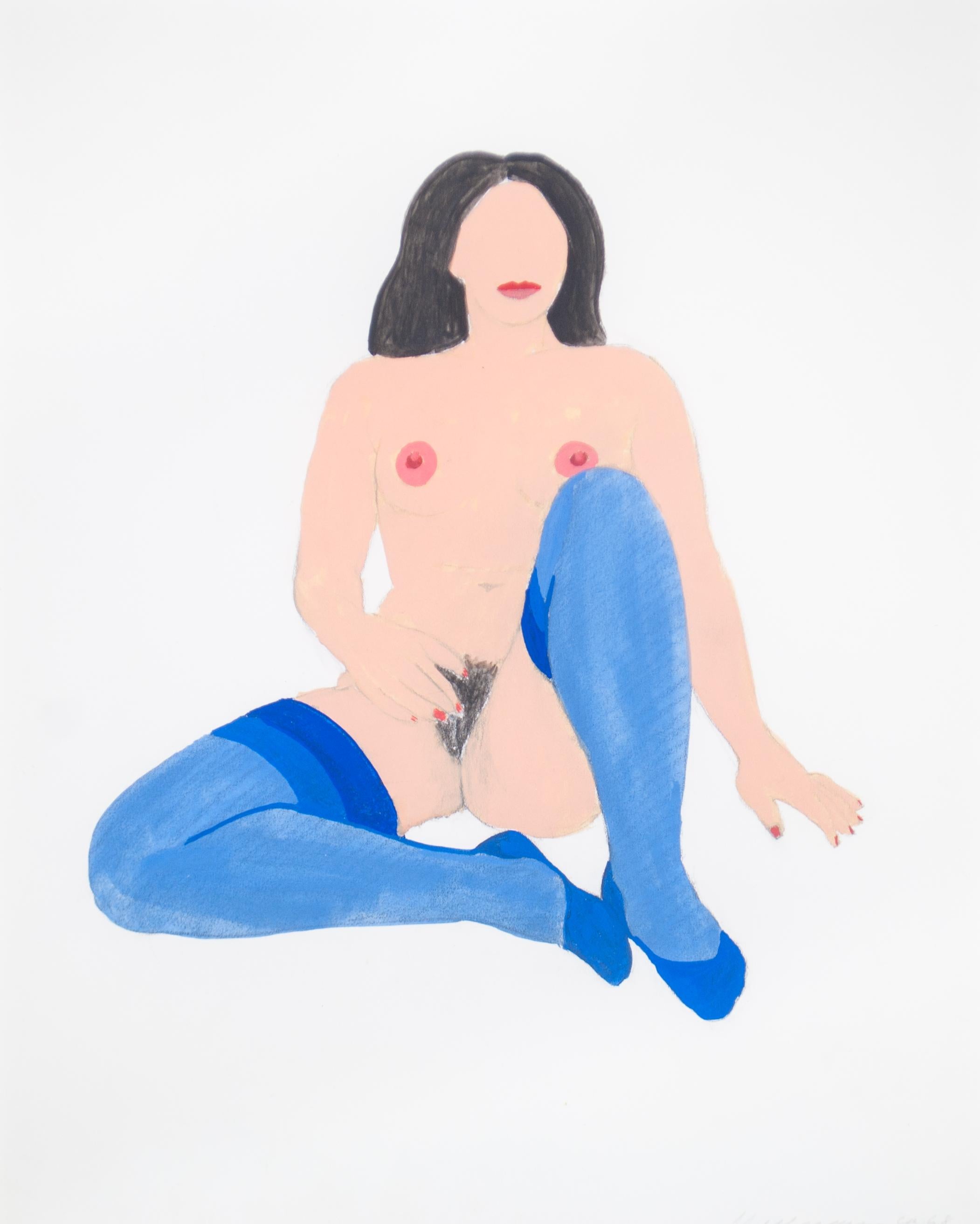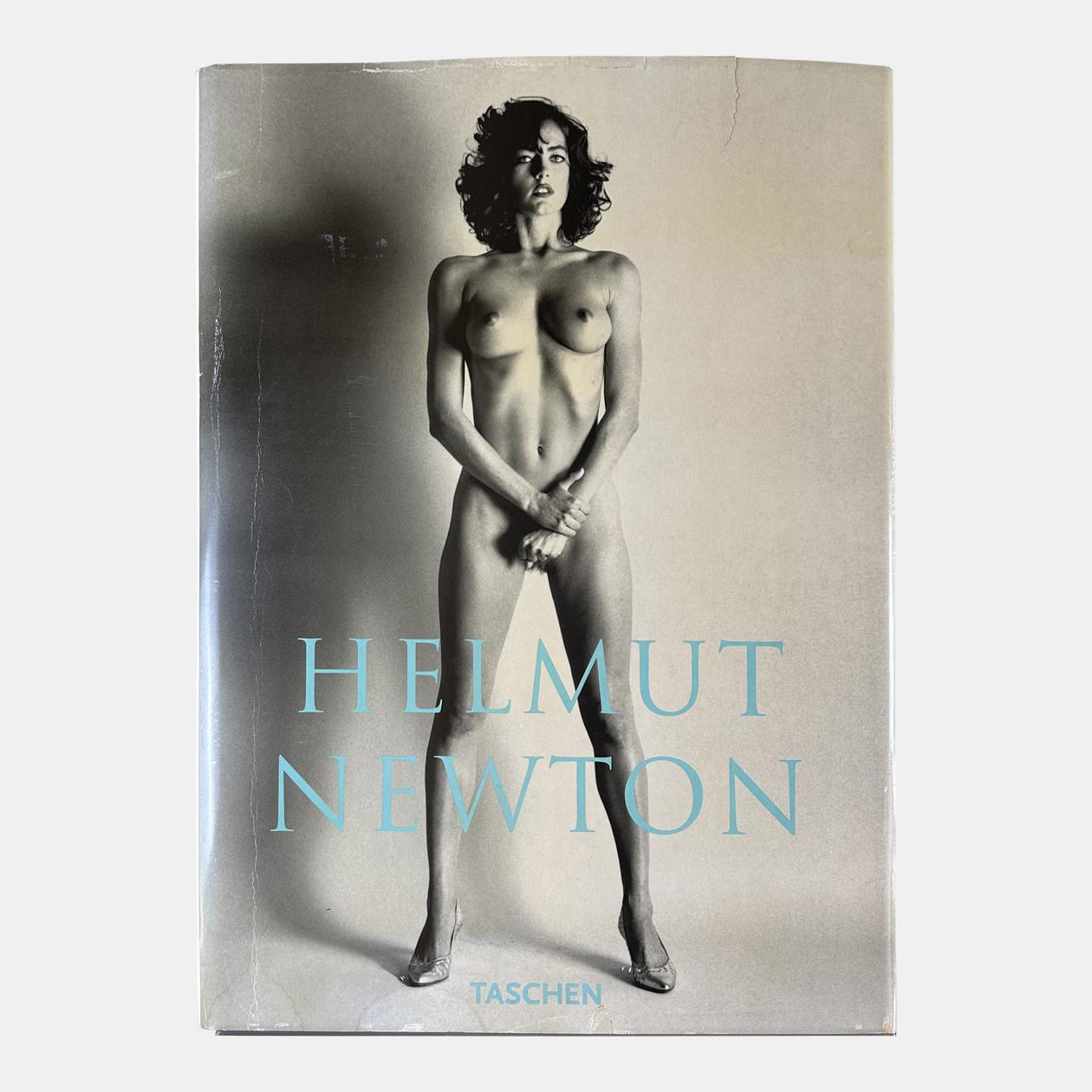Want more images or videos?
Request additional images or videos from the seller
1 of 10
Noche Crist"Succubus Festival"1974
1974
About the Item
Silkscreen work by Noche Crist (1909- 2004). Marked in pencil 7/9 lower left. Printed in 1974 by the artist. Image is from her "Succubus Festival" series. Catalogue of a postumous retrospective in 2008 at the American University Museum Katzen Arts Center in Washington D.C. is included.
The Romanian born, self-taught artist is known for her acrylic paintings on wooden panels and shaped transparent polyester resin sculptures that create images reminiscent of her childhood at her family's country estate outside Bucharest. Her works depict dreamlike, surreal scenes of partially dressed women posing seductively in opulent, sometimes fantastical, settings. In other paintings and panels, she portrays bare-breasted women and felines sensually intertwined. Noche Crist was well known not only for her paintings and sculptures but also her storytelling and entertaining that helped turn her into a legendary figure in the Washington D.C. art scene. Her works gained a following among art patrons, including Olga Hirshhorn, one of Washington's leading art collectors.
- Creator:Noche Crist (1909 - 2004)
- Creation Year:1974
- Dimensions:Height: 30 in (76.2 cm)Width: 22 in (55.88 cm)
- Medium:
- Movement & Style:
- Period:
- Condition:
- Gallery Location:Washington, DC
- Reference Number:1stDibs: LU133727715912
About the Seller
5.0
Vetted Seller
These experienced sellers undergo a comprehensive evaluation by our team of in-house experts.
1stDibs seller since 2020
40 sales on 1stDibs
- ShippingRetrieving quote...Ships From: Washington, DC
- Return PolicyA return for this item may be initiated within 14 days of delivery.
More From This SellerView All
- Year of the RamLocated in Washington, DCSilkscreen work by Noche Crist (1909- 2004). Marked in pencil 3/15 lower left. Printed by the artist in the 1970s. Image is from her Year of the Ram series...Category
1970s Outsider Art Nude Prints
MaterialsPaper
- Women Loving WoomenLocated in Washington, DCSigned silkscreen work by Noche Crist (1909- 2004). From Women Loving Woomen series. Wonderful work printed by the artist on thick paper. Catalogue of a postumous retrospective in...Category
1970s Outsider Art Nude Prints
MaterialsPaper
- "Sitting Bull Goes To Washington"Located in Washington, DCSilkscreen work by Noche Crist (1909- 2004). Work is from from her "Sitting Bull Goes to Washington" series. Marked in pencil 15/18 lower left. Printed in 1976 by the artist. Catalo...Category
1970s Outsider Art Figurative Prints
MaterialsPaper
- "Carousel"Located in Washington, DCSilkscreen work by Noche Crist (1909- 2004). Marked in pencil 28/30 lower left. Printed in 1973 by the artist. Image is from her "Carrousel" series. Catalogue of a postumous retrospe...Category
1970s Outsider Art Animal Prints
MaterialsPaper, Ink
- Noche Crist SculptureLocated in Washington, DCOne of a kind sculpture by Noche Crist (1909-2004). Noche Crist was an American artist born in Romania. Sculpture is made from polyester resin. Catalogue o...Category
1970s Outsider Art Nude Sculptures
MaterialsAcrylic Polymer
- Girl with CatLocated in Washington, DCPainting by Noche Crist (1909 - 2004). Work is untitled and signed. Measures 22" x 12". Painting is casein paint and plaster on board. Catalogue of an exhibition in 2008 at the...Category
1960s Outsider Art Figurative Paintings
MaterialsAcrylic
You May Also Like
- Steam Bath, AniakLocated in San Francisco, CAThis artwork titled "Steam Bath, Aniak" 1995 is a color offset lithograph on paper by noted American artist Rie Mounier Munoz, 1921-2015. It is hand signed and numbered 38/950 in pencil by the artist. The image size is 6.75 x 10 inches, sheet size is 10.5 x 14 inches. It is in excellent condition.. About the artist: Alaska painter Rie Mounier Munoz was the child of Dutch parents who immigrated to California, where she was born and raised. She is known for her colorful scenes of everyday life in Alaska. Rie (from Marie) Munoz (moo nyos), studied art at Washington and Lee University in Virginia. In 1950, she traveled up the Inside Passage by steamship, fell in love with Juneau, and gave herself until the boat left the next day to find a job and a place to live. Since then Juneau has been home to Munoz. She began painting small vignettes of Alaska soon after arriving in Juneau, and also studied art at the University of Alaska-Juneau. Munoz painted in oils in what she describes as a "painstakingly realistic" style, which she found stiff and "somewhat boring." Her breakthrough came a few years later when an artist friend introduced her to a versatile, water-soluble paint called casein. The immediacy of this inexpensive medium prompted an entirely new style. Rie's paintings became colorful and carefree, mirroring her own optimistic attitude toward life. With her newfound technique she set about recording everyday scenes of Alaskans at work and at play. Of the many jobs she has held journalist, teacher, museum curator, artist, mother, Munoz recalls one of her most memorable was as a teacher on King Island in 1951, where she taught 25 Eskimo children. The island was a 13-hour umiak (a walrus skin boat) voyage from Nome, an experience she remembers vividly. After teaching in the Inupiat Eskimo village on the island with her husband during one school year, she felt a special affinity for Alaska's Native peoples and deliberately set about recording their traditional lifestyles that she knew to be changing very fast. For the next twenty years, Rie practiced her art as a "Sunday painter," in and around prospecting with her husband, raising a son, and working as a freelance commercial artist, illustrator, cartoonist, and curator of exhibits for the Alaska State Museum. During her years in Alaska, Munoz has lived in a variety of small Alaskan communities, including prospecting and mining camps. Her paintings reflect an interest in the day-to-day activities of village life such as fishing, berry picking, children at play, as well as her love of folklore and legends. Munoz says that what has appealed to her most were "images you might not think an artist would want to paint," such as people butchering crab, skinning a seal, or doing their laundry in a hand-cranked washing machine. In 1972, with her hand-cut stencil and serigraph prints selling well in four locations in Alaska, she felt confident enough to leave her job at the Alaska State Museum and devote herself full time to her art. Freed from the constraints of an office job, she began to produce close to a hundred paintings a year, in addition to stone lithograph and serigraph prints. From her earliest days as an artist, Rie had firm beliefs about selling her work. First, she insisted the edition size should be kept modest. When she decided in 1973 to reproduce Eskimo Story Teller as an offset lithography print and found the minimum print run to be 500, she destroyed 200 of the prints. She did the same with King Island, her second reproduction. Reluctantly, to meet market demand, she increased the edition size of the reproductions to 500 and then 750. The editions stayed at that level for almost ten years before climbing to 950 and 1250. Her work has been exhibited many solo watercolor exhibits in Alaska, Oregon and Washington State, including the Charles and Emma Frye Art Museum, Alaska State Museum in Juneau, Anchorage Historical and Fine Arts Museum, Tongass Historical Museum in Ketchikan, and Yukon Regional Library in Whitehorse; Yukon Territory, and included in exhibits at the Smithsonian Institute and Russell Senate Office Building in Washington, D.C. Munozs paintings have graced the covers of countless publications, from cookbooks to mail order catalogs, and been published in magazines, newspapers, posters, calendars, and two previous collections of her work: Rie Munoz...Category
Late 20th Century Folk Art Nude Prints
MaterialsLithograph
- Singing in the Bath, Tenakee SpringsLocated in San Francisco, CAThis artwork titled "Singing in the Bath, Tenakee Springs" 1996 is a color offset lithograph on paper by noted American artist Rie Mounier Munoz, 1921-2015. It is hand signed and numbered 1077/1100 in pencil by the artist. The image size is 13.5 x 10 inches, sheet size is 16 x 12.35 inches. It is in excellent condition, has never been framed. About the artist: Alaska painter Rie Mounier Munoz was the child of Dutch parents who immigrated to California, where she was born and raised. She is known for her colorful scenes of everyday life in Alaska. Rie (from Marie) Munoz (moo nyos), studied art at Washington and Lee University in Virginia. In 1950, she traveled up the Inside Passage by steamship, fell in love with Juneau, and gave herself until the boat left the next day to find a job and a place to live. Since then Juneau has been home to Munoz. She began painting small vignettes of Alaska soon after arriving in Juneau, and also studied art at the University of Alaska-Juneau. Munoz painted in oils in what she describes as a "painstakingly realistic" style, which she found stiff and "somewhat boring." Her breakthrough came a few years later when an artist friend introduced her to a versatile, water-soluble paint called casein. The immediacy of this inexpensive medium prompted an entirely new style. Rie's paintings became colorful and carefree, mirroring her own optimistic attitude toward life. With her newfound technique she set about recording everyday scenes of Alaskans at work and at play. Of the many jobs she has held journalist, teacher, museum curator, artist, mother, Munoz recalls one of her most memorable was as a teacher on King Island in 1951, where she taught 25 Eskimo children. The island was a 13-hour umiak (a walrus skin boat) voyage from Nome, an experience she remembers vividly. After teaching in the Inupiat Eskimo village on the island with her husband during one school year, she felt a special affinity for Alaska's Native peoples and deliberately set about recording their traditional lifestyles that she knew to be changing very fast. For the next twenty years, Rie practiced her art as a "Sunday painter," in and around prospecting with her husband, raising a son, and working as a freelance commercial artist, illustrator, cartoonist, and curator of exhibits for the Alaska State Museum. During her years in Alaska, Munoz has lived in a variety of small Alaskan communities, including prospecting and mining camps. Her paintings reflect an interest in the day-to-day activities of village life such as fishing, berry picking, children at play, as well as her love of folklore and legends. Munoz says that what has appealed to her most were "images you might not think an artist would want to paint," such as people butchering crab, skinning a seal, or doing their laundry in a hand-cranked washing machine. In 1972, with her hand-cut stencil and serigraph prints selling well in four locations in Alaska, she felt confident enough to leave her job at the Alaska State Museum and devote herself full time to her art. Freed from the constraints of an office job, she began to produce close to a hundred paintings a year, in addition to stone lithograph and serigraph prints. From her earliest days as an artist, Rie had firm beliefs about selling her work. First, she insisted the edition size should be kept modest. When she decided in 1973 to reproduce Eskimo Story Teller as an offset lithography print and found the minimum print run to be 500, she destroyed 200 of the prints. She did the same with King Island, her second reproduction. Reluctantly, to meet market demand, she increased the edition size of the reproductions to 500 and then 750. The editions stayed at that level for almost ten years before climbing to 950 and 1250. Her work has been exhibited many solo watercolor exhibits in Alaska, Oregon and Washington State, including the Charles and Emma Frye Art Museum, Alaska State Museum in Juneau, Anchorage Historical and Fine Arts Museum, Tongass Historical Museum in Ketchikan, and Yukon Regional Library in Whitehorse; Yukon Territory, and included in exhibits at the Smithsonian Institute and Russell Senate Office Building in Washington, D.C. Munozs paintings have graced the covers of countless publications, from cookbooks to mail order catalogs, and been published in magazines, newspapers, posters, calendars, and two previous collections of her work: Rie Munoz...Category
Late 20th Century Folk Art Nude Prints
MaterialsLithograph
- Blue SocksBy Tom WesselmannLocated in Ljubljana, SIBlue Socks. Original color liquitex on Ragboard, 1968. Tom Wesselmann is one of the biggest American pop artists today. Even he did not like being labeled a pop artist, it is hard to...Category
1960s Pop Art Nude Prints
MaterialsAcrylic, Rag Paper
- SUMOBy Helmut NewtonLocated in Tokyo, 13LOT:20230825S01 Helmut Newton [SUMO] Hardcover, book stand designed by Philippe Starck Artist signed and numbered 70 x 50 cm, 34.8 kg, 464 pages Publisher: Taschen Condition: There a...Category
1990s Nude Prints
MaterialsPaper
- The TwoBy Anders ZornLocated in Tallinn, EEAnders Zorn (Utmeland/Dalarne, 1860 - Mora/Sweden, 1920) The Two", 1916 Signed in pencil lower right and monogrammed and dated in the plate. Etching on laid paper. 35,5 x 23 cm; 20,2...Category
1910s Figurative Prints
MaterialsLaid Paper, Etching
- Contemporary Nude Etching by John EmanuelBy John EmanuelLocated in Brecon, PowysSigned Limited Edition Etching 32 of 75 the artist more known for his Gouache and Oil paintings has here put his hand to an etching. Image 16" x 11"Category
21st Century and Contemporary Contemporary Nude Prints
MaterialsPaper



